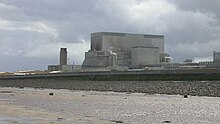Hinkley Point B
Hinkley Point B is a nuclear power station near Bridgwater, Somerset, on the Bristol Channel coast of south west England. It was the first commercial Advanced Gas Cooled reactor to generate power to the National Grid in 1976 and shares its design with sister station Hunterston B nuclear power station.
The construction of Hinkley Point B, which was undertaken by a consortium known as The Nuclear Power Group (TNPG), started in 1967. The reactors vessels were supplied by Whessoe, reactor machinery was supplied by Strachan & Henshaw and the turbines by GEC.
In March 1971 it was announced that there would be a six-month delay in completion due to problems with the insulation of the concrete pressure vessel. In place of the stainless steel mesh and foil insulation that had been used on previous Magnox stations, a fibrous type of insulation supplied by Delaney Gallay, part of the Lindustries Group, had been used for the first time. During pre-operational trials, before the nuclear fuel was loaded, high levels of acoustic vibration in the gas circuit were found to be damaging the insulation tiles, and the retention plates which held the insulation in place had to be redesigned and modified within the reactor.
During further pre-operational testing, severe vibration of the fuel channel gags was detected. The fuel channel gags are valves which are gradually closed to restrict the flow of gas through a fuel channel in order to maintain the channel gas outlet temperature as the nuclear fuel is used up. Modifications to produce a fluidically generated bias force to stop the gags vibrating took time to design, test and implement, delaying the planned start up date. The station began generating electricity on 5 February 1976.
It was taken over by Nuclear Electric as part of the privatisation of the UK Electricity Supply Industry in 1990, though remaining in public ownership at that time. In 1996, the AGR and PWR assets of Nuclear Electric and Scottish Nuclear were privatised as part of British Energy.
...
Wikipedia


